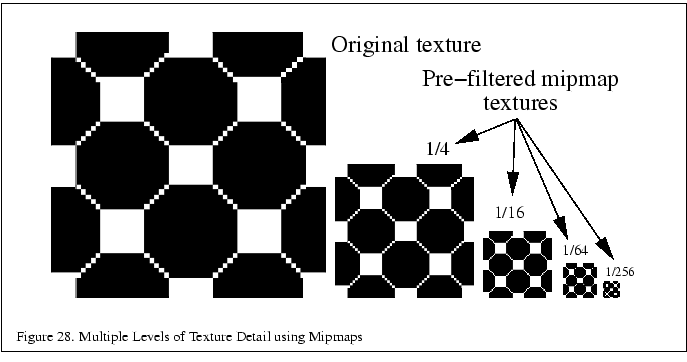
The texture image is a discrete array of texels, but the texture coordinates vary continuously (at least conceptually). This creates a sampling problem. In addition, a fragment can really be thought of as covering some region of the texture image (the fragment's footprint). Filtering also tries to account for a fragment's footprint within the texture image.
OpenGL provides a number of filtering methods to compute the texel value. There are separate filters for magnification (many pixel fragment values map to one texel value) and minification (many texel values map to one pixel fragment). The simplest of the filters is point sampling, in which the texel value nearest the texture coordinates is selected. Point sampling seldom gives satisfactory results, so most applications choose some filter which interpolates. For magnification, OpenGL only supports linear interpolation between four texel values. For minification, OpenGL supports various types of mipmapping [107], with the most useful (and computationally expensive) being tri-linear mipmapping (four samples taken from each of the nearest two mipmap levels and then interpolating the two sets of samples). Some vendors have also added an extension called SGIS_texture_filter4 that provides a larger filter kernel in which the weighted sum of a 4x4 array of texels is used.

With mipmapping, a texture consists of multiple levels-of-detail (LODs). Each mipmap level is a distinct texture image. The base mipmap level has the highest resolution and is called mipmap level zero. Each subsequent level is half the dimensions (height, width, and depth) until each dimension goes to one and finally all the dimensions reduce to one. For mipmap filtering to work reasonably, each subsequent mipmap level is down-sampled version of the previous mipmap level texture image. Figure 28 shows how texture mipmap levels provide multiple LODs for a base texture image. OpenGL does not provide any built-in commands for generating mipmaps, but the GLU provides some simple routines (gluBuild1DMipmaps(), gluBuild2DMipmaps(), and gluBuild3DMipmaps()3) for generating mipmaps using a simple box filter.
During texturing, OpenGL automatically computes (or more likely,
approximates) each fragment's LOD parameter based on the partial
derivatives of the primitive's mapping of texture coordinates to window
coordinates. This LOD parameter is often called lambda (![]() ).
The integer portion of the lambda value determines which mipmap levels
to use for mipmap filtering and the fractional portion of the lambda
value determines the weighting for selecting or blending mipmaps levels.
Because OpenGL handles mipmapping automatically, the details of
LOD computation are most interesting to OpenGL implementors, but it
is important that users of OpenGL understand the interpolation math
so that they will not be surprised by unexpected results.
).
The integer portion of the lambda value determines which mipmap levels
to use for mipmap filtering and the fractional portion of the lambda
value determines the weighting for selecting or blending mipmaps levels.
Because OpenGL handles mipmapping automatically, the details of
LOD computation are most interesting to OpenGL implementors, but it
is important that users of OpenGL understand the interpolation math
so that they will not be surprised by unexpected results.